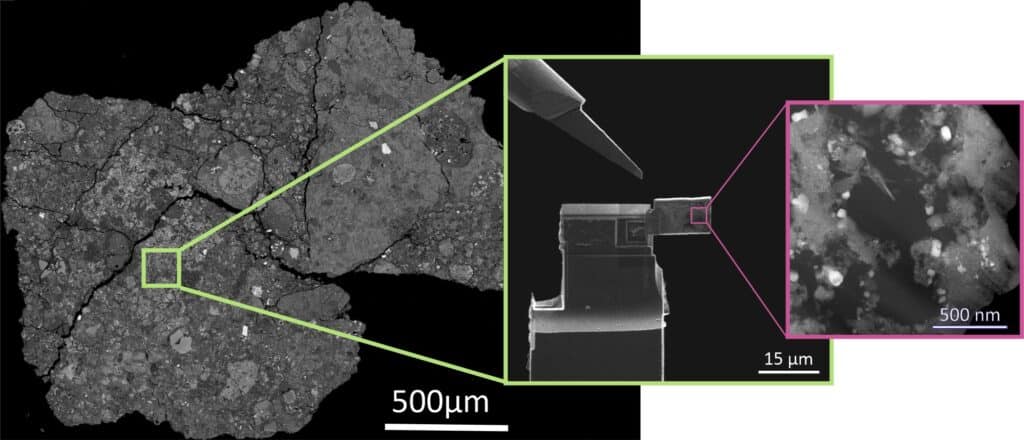Meteorite fragments are unlocking secrets to the building blocks of life. Scientists from the Institute of Mineralogy at Münster University in Germany have identified crucial nitrogen compounds, including amino acids and heterocyclic hydrocarbons, in the Winchcombe meteorite. This find represents a significant stride in understanding the origins of life and matter in our solar system.
What sets this research apart is the method used: the compounds were detected without any chemical treatment of the meteorite, thanks to a novel type of detector design.
Meteorites, fragments of asteroids that crash to Earth, are like cosmic time capsules. They contain primordial substances from which our solar system originated, offering scientists invaluable insights into the early universe and the beginnings of life on Earth. The Winchcombe meteorite, observed falling in England in February 2021 and swiftly collected, provided a pristine specimen for study.

“Normally, meteorites are tracked down in the cold and hot deserts on Earth, where the dry climate means that they don’t weather very fast, but they do change as a result of humidity,” says study lead author Dr. Christian Vollmer, from the Institute of Mineralogy at Münster University, in a media release. “If a meteorite fall is observed soon after the event and the meteorite is quickly collected, as was the case in Winchcombe, they are important ‘witnesses’ for us regarding the birth of our solar system — which makes them especially interesting for research purposes.”
The origins of life on Earth remain one of the greatest mysteries, with some theories suggesting that meteorites brought the first biologically relevant matter to our planet over four billion years ago. This matter includes complex organic compounds such as amino acids and hydrocarbons, essential for life. Traditionally, to study these compounds in meteorites, scientists have had to extract them using solvents or acids. However, Dr. Vollmer’s team achieved a first by detecting these substances in the Winchcombe meteorite without any chemical treatment.
What is the Winchcombe Meteorite?
The Winchcombe Meteorite refers to a stony meteorite that fell to Earth and was recovered in the town of Winchcombe, Gloucestershire, England, in February 2021. This meteorite is particularly significant for several reasons:
- Rare Classification: It was classified as a carbonaceous chondrite, a type of stony meteorite rich in organic compounds and water, providing valuable insights into the early solar system and the building blocks of life.
- Freshness: The meteorite was retrieved quickly after its fall, which means it was minimally contaminated by Earth’s environment. This provides scientists with a pristine sample of space material, offering a clearer picture of its original composition.
- Observed Fall: The meteorite’s fall was observed through the UK Fireball Alliance (UKFAll) camera network, allowing scientists to trace its trajectory and origins in space. This helps in understanding the meteorite’s journey through the solar system before it landed on Earth.
- Scientific Importance: The Winchcombe Meteorite’s composition and the conditions it endured on its way to Earth can help researchers understand more about the early solar system, including the formation of planets and the origins of water and organic molecules on Earth.
- Cultural Impact: The meteorite’s fall and recovery were widely covered by media, raising public interest in meteoritics, astronomy, and space science. It also highlights the importance of quick response by scientists and the public in recovering meteoritic materials.
The team utilized a high-resolution electron microscope at the SuperSTEM laboratory in Daresbury, England. This advanced microscope not only provides images at atomic resolution but can also chemically analyze samples with a new type of detector.
“Demonstrating the existence of these biologically relevant organic compounds in an untreated meteorite is a significant achievement for research,” notes Dr. Vollmer. “It shows that these building blocks of life can be characterized in these cosmic sediments even without chemical extraction.”

This methodology is crucial as it avoids the risk of altering the fragile compounds during chemical treatment.
This breakthrough is not only a milestone for astrobiology and the study of the solar system’s origins but also has implications for future space missions. The non-invasive technique developed by Dr. Vollmer and his team could be invaluable for analyzing small, extraterrestrial samples returned to Earth, such as the dust particles from asteroids collected by missions like Japan’s Hayabusa2 and NASA’s OSIRIS-REx.
The study is published in the journal Nature Communications.













Comments